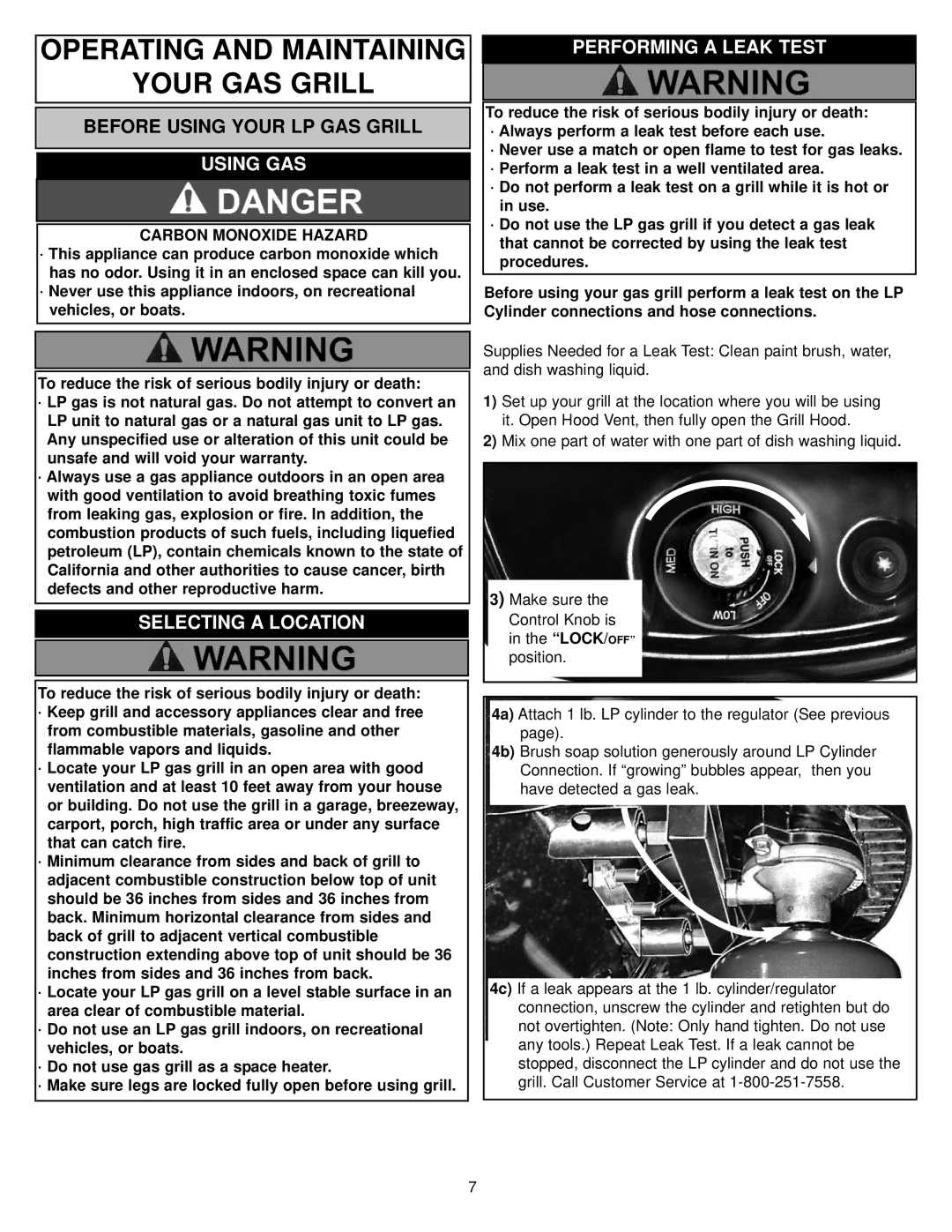
OPERATING AND MAINTAINING
YOUR GAS GRILL
BEFORE USING YOUR LP GAS GRILL
USING GAS
CARBON MONOXIDE HAZARD
·This appliance can produce carbon monoxide which has no odor. Using it in an enclosed space can kill you.
·Never use this appliance indoors, on recreational vehicles, or boats.
To reduce the risk of serious bodily injury or death:
·LP gas is not natural gas. Do not attempt to convert an LP unit to natural gas or a natural gas unit to LP gas. Any unspecified use or alteration of this unit could be unsafe and will void your warranty.
·Always use a gas appliance outdoors in an open area with good ventilation to avoid breathing toxic fumes from leaking gas, explosion or fire. In addition, the combustion products of such fuels, including liquefied petroleum (LP), contain chemicals known to the state of California and other authorities to cause cancer, birth defects and other reproductive harm.
SELECTING A LOCATION
PERFORMING A LEAK TEST
To reduce the risk of serious bodily injury or death:
·Always perform a leak test before each use.
·Never use a match or open flame to test for gas leaks.
·Perform a leak test in a well ventilated area.
·Do not perform a leak test on a grill while it is hot or in use.
·Do not use the LP gas grill if you detect a gas leak that cannot be corrected by using the leak test procedures.
Before using your gas grill perform a leak test on the LP Cylinder connections and hose connections.
Supplies Needed for a Leak Test: Clean paint brush, water, and dish washing liquid.
1)Set up your grill at the location where you will be using it. Open Hood Vent, then fully open the Grill Hood.
2)Mix one part of water with one part of dish washing liquid.
3) Make sure the Control Knob is in the “LOCK/OFF” position.
To reduce the risk of serious bodily injury or death:
·Keep grill and accessory appliances clear and free from combustible materials, gasoline and other flammable vapors and liquids.
·Locate your LP gas grill in an open area with good ventilation and at least 10 feet away from your house or building. Do not use the grill in a garage, breezeway, carport, porch, high traffic area or under any surface that can catch fire.
·Minimum clearance from sides and back of grill to adjacent combustible construction below top of unit should be 36 inches from sides and 36 inches from back. Minimum horizontal clearance from sides and back of grill to adjacent vertical combustible construction extending above top of unit should be 36 inches from sides and 36 inches from back.
·Locate your LP gas grill on a level stable surface in an area clear of combustible material.
·Do not use an LP gas grill indoors, on recreational vehicles, or boats.
·Do not use gas grill as a space heater.
·Make sure legs are locked fully open before using grill.
4a) Attach 1 lb. LP cylinder to the regulator (See previous page).
4b) Brush soap solution generously around LP Cylinder Connection. If “growing” bubbles appear, then you have detected a gas leak.
4c) If a leak appears at the 1 lb. cylinder/regulator connection, unscrew the cylinder and retighten but do not overtighten. (Note: Only hand tighten. Do not use any tools.) Repeat Leak Test. If a leak cannot be stopped, disconnect the LP cylinder and do not use the grill. Call Customer Service at
7
